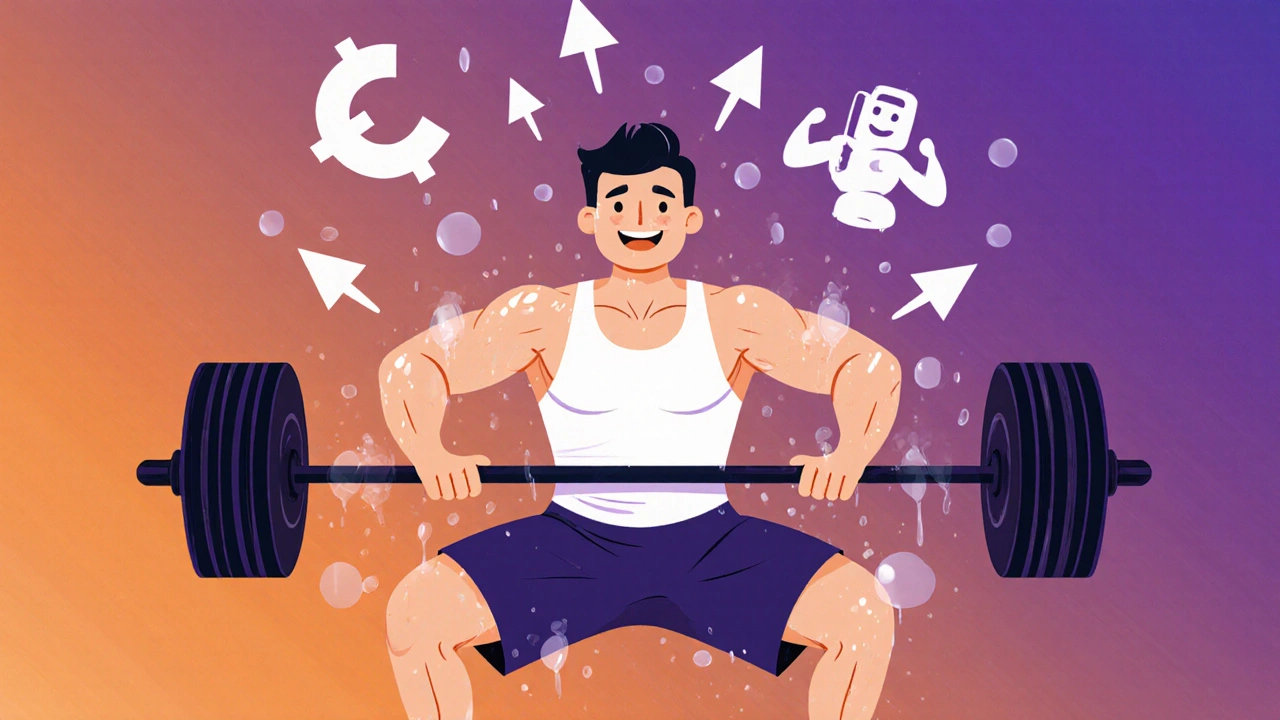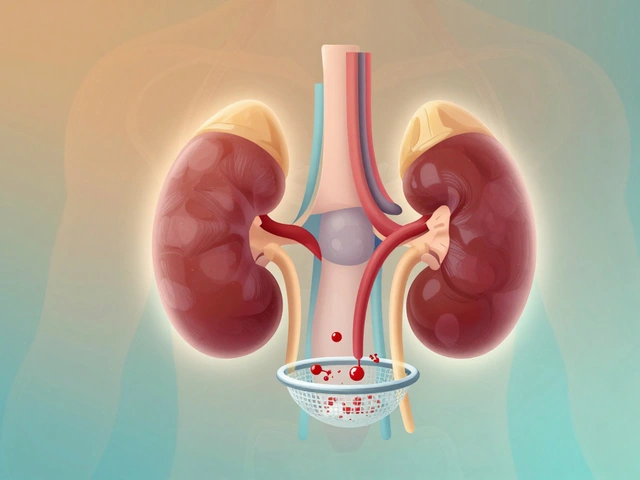Want to lose fat but tired of seeing the scale barely move after hours on the treadmill? You’re not alone. Most people think cardio is the only way to burn fat. But here’s the truth: strength training is the most effective tool you’re not using. It doesn’t just burn calories during the workout-it changes your body’s ability to burn fat for weeks afterward. And it keeps the muscle you’ve worked so hard to build.
Why Strength Training Beats Cardio for Fat Loss
Cardio burns calories while you’re doing it. That’s it. Once you stop, your metabolism goes back to normal. Strength training? It turns your body into a fat-burning machine even when you’re sitting on the couch. Each pound of muscle burns 6-10 calories a day at rest. Fat? Only 2-3. That means if you gain 5 pounds of muscle and lose 5 pounds of fat, you’re burning an extra 15-35 calories every single day-without lifting a finger. Over a year, that’s 5-12 pounds of extra fat burned just from having more muscle. Studies show people who lift weights while cutting calories lose 95% of their muscle mass, while those who do only cardio lose up to 12% of it. That’s not just about looking good-it’s about keeping your metabolism high. When you lose muscle, your body slows down. You burn fewer calories. You regain weight faster. Strength training stops that cycle. The afterburn effect-called EPOC (excess post-exercise oxygen consumption)-is real. After a heavy strength session, your body keeps burning extra calories for up to 72 hours. A 2018 study found people burned 6-15% more total calories in the 3 days after lifting than after steady-state cardio. That’s like getting a free workout for two extra days.How to Structure Your Strength Program for Fat Loss
You don’t need to lift like a bodybuilder. You need to lift smart. Rep ranges: 8-15 reps per set. For big lifts like squats, deadlifts, and bench presses, stick to 8-12 reps. For smaller moves like bicep curls or lateral raises, go 12-15. This range hits the sweet spot: enough weight to build muscle, enough reps to keep your heart rate up and burn fat. Sets: 3-5 per exercise. More than 5? You’re overdoing it. Less than 3? You’re not stimulating enough muscle. Three solid sets with good form beat five sloppy ones. Rest: 2-3 minutes between heavy sets. This lets your muscles recover enough to lift hard again. For faster-paced circuits (more on that later), drop rest to 30-60 seconds. Tempo: Use a 2-0-2 pattern. Two seconds lifting, no pause at the top, two seconds lowering. Slowing the descent increases time under tension-which means more muscle damage, more growth, and more calories burned. Frequency: 3 strength sessions per week. Full-body workouts are best for beginners. Once you’ve been lifting for 4-6 weeks, switch to upper/lower splits to hit muscles harder.Best Exercises for Fat Loss
Not all exercises are created equal. Pick the ones that move the most weight and use the most muscles.- Squats (barbell or dumbbell)
- Deadlifts (conventional or Romanian)
- Bench press (dumbbell or barbell)
- Overhead press
- Rows (bent-over or seated cable)
- Pull-ups or lat pulldowns
- Lunges (walking or stationary)
Progressive Overload: The Secret Sauce
If you’re lifting the same weight every week, you’re not getting stronger. And if you’re not getting stronger, you’re not building muscle. And if you’re not building muscle, you’re not boosting your metabolism. The rule is simple: when you can hit the top of your rep range (e.g., 12 reps) with good form on all sets, increase the weight. - Women: Add 5-10 lbs on lower body lifts, 2-5 lbs on upper body. - Men: Add 10-15 lbs on lower body, 5-10 lbs on upper body. Track your lifts. Write them down. Don’t guess. If you don’t measure, you don’t improve. A 2023 analysis of 500 Amazon reviews found that 87% of people who saw real results tracked their weights weekly. The rest? They plateaued.
Cardio? Yes-but the Right Kind
Strength training is the engine. Cardio is the fuel. Do 2 cardio sessions per week:- One steady-state: 30-45 minutes at a moderate pace (you can talk but not sing). Keep heart rate at 65-75% of max.
- One HIIT: 20 minutes total. Do 1 minute of high intensity (jumping jacks, burpees, rowing) followed by 3 minutes of easy walking or cycling. Repeat 5 times.
Nutrition: You Can’t Out-Lift a Bad Diet
No amount of lifting will fix a diet full of processed food and sugar. Fat loss happens in the kitchen. Aim for:- Protein: 1.6-2.2 grams per kilogram of body weight. That’s about 120-150g per day for a 150-lb person.
- Carbs: 30% of calories. Focus on whole grains, fruits, vegetables.
- Fats: 30% of calories. Avocados, nuts, olive oil, fatty fish.
What to Track (Besides the Scale)
The scale lies. Especially when you’re building muscle and losing fat. You might gain 2 pounds on the scale but lose 4 inches off your waist. That’s not weight gain-that’s body recomposition. Track these instead:- Waist, hips, chest, and thigh measurements (every 2 weeks)
- Progress photos (same lighting, same time of day, same clothes)
- How your clothes fit
- Strength gains (are you lifting heavier?)

Common Mistakes (And How to Fix Them)
- Mistake: Skipping warm-ups. Fix: Do 5-10 minutes of light cardio (walking, cycling) and 3 dynamic stretches (leg swings, arm circles, bodyweight squats).
- Mistake: Using poor form to lift heavier. Fix: Record yourself doing squats or deadlifts. Compare to YouTube videos from certified trainers. If your lower back rounds on a deadlift, you’re at risk for injury. Stop and reset.
- Mistake: Doing too much too soon. Fix: Start with 30-minute sessions. Build up to 45. Your joints and tendons need time to adapt.
- Mistake: Ignoring recovery. Fix: Get 7-8 hours of sleep. Walk 10 minutes after workouts. Use a foam roller for 10 minutes on sore days. Studies show this cuts muscle soreness by 35%.
Real People, Real Results
On Reddit, user FitJourney2023 lost 48 pounds over 6 months with 3x weekly strength training and intermittent fasting. The scale only showed 32 pounds lost. The other 16? Muscle gained. Body fat dropped from 32% to 19%. CardioQueen99 spent 8 months doing only cardio. Lost 25 pounds. Looked ‘skinny fat.’ Added strength training. In 12 weeks, her body looked completely different. The Women’s Health 4-Week Strength Plan had over 1,200 reviews. The most common comment: ‘Week 3’s weight increase made me feel strong for the first time.’What’s Next? AI and Wearables Are Changing the Game
Wearable tech like WHOOP and Apple Watch now track muscle preservation during weight loss. Tonal’s new AI system adjusts your weights in real time based on how tired you are. Apple Fitness+ has 25-minute metabolic strength workouts designed specifically for fat loss. But the core hasn’t changed. Still need to lift heavy. Still need to eat protein. Still need to sleep. Still need to track progress. Technology just helps you stay consistent.Final Thought: It’s Not About Losing Weight. It’s About Gaining Control.
Fat loss isn’t a race. It’s a rebuild. You’re not just burning fat-you’re rebuilding your metabolism, your strength, your confidence. Strength training gives you something cardio never can: a body that looks and feels powerful. One that burns fat even when you’re not working out. One that lasts. Start today. Pick three lifts. Do them 3 times a week. Get stronger. Eat protein. Track your measurements. And don’t look at the scale for at least 4 weeks. Your future self will thank you.Can I lose fat with strength training alone?
Yes, but it’s slower than combining it with cardio and nutrition. Strength training builds muscle, which increases your resting metabolism and helps you burn fat over time. But if you’re eating too many calories, you won’t lose fat-no matter how much you lift. For fastest results, pair strength training with a moderate calorie deficit and 2 weekly cardio sessions.
How long until I see results from strength training for fat loss?
Most people start seeing changes in body shape and clothing fit between weeks 3 and 6. The scale might not move for the first 2-3 weeks because you’re gaining muscle while losing fat. Don’t rely on weight alone. Take measurements and progress photos every 2 weeks. Real results show up in how you look and feel, not just the number on the scale.
Do I need a gym to do strength training for fat loss?
No. You can do effective fat-loss strength training at home with dumbbells, resistance bands, and bodyweight exercises. Squats, lunges, push-ups, rows with bands, and glute bridges are all powerful moves. You don’t need a barbell or machines to build muscle and burn fat. Many people get better results at home because they’re more consistent.
Should I do cardio on my rest days?
Yes, but keep it light. On rest days from lifting, do 30-45 minutes of walking, cycling, or swimming at a low intensity. This helps with recovery, improves circulation, and burns extra calories without interfering with muscle growth. Save high-intensity cardio for your scheduled days-don’t do it right after lifting.
I’m a woman. Will strength training make me bulky?
No. Women don’t have enough testosterone to build large, bulky muscles like men. Strength training will help you lose fat, tighten your shape, and get toned. Most women who think they’re getting ‘bulky’ are actually seeing muscle definition for the first time-which looks leaner, not bigger. If you’re worried, stick to 8-15 rep ranges and avoid extreme calorie surpluses. You’ll get strong and sculpted, not massive.
How much protein do I need for fat loss and muscle gain?
Aim for 1.6-2.2 grams of protein per kilogram of body weight. For a 150-pound person, that’s about 110-150 grams per day. Spread it across 3-4 meals. Good sources: chicken, fish, eggs, Greek yogurt, tofu, lentils, protein powder. Eating protein after your workout boosts muscle repair and helps you hold onto lean mass while losing fat.
What if I get too sore to move?
Delayed soreness (DOMS) is normal, especially when you start. It peaks at 48 hours and fades by day 3-4. Don’t skip workouts because you’re sore-just modify. Do light walking, stretching, or foam rolling. Studies show 10 minutes of post-workout walking reduces soreness duration by 35%. If you’re in real pain or can’t move normally, take an extra rest day. But don’t confuse soreness with injury.
Is strength training safe for older adults?
Yes, and it’s critical. As we age, we naturally lose muscle-up to 3-8% per decade after 30. Strength training reverses this. Start with bodyweight exercises and light dumbbells. Focus on form, not weight. Work with a trainer for the first few sessions if you’re unsure. Studies show older adults who lift weights improve balance, reduce fall risk, and maintain independence longer. It’s not just about fat loss-it’s about staying strong for life.




Bryson Carroll on 22 November 2025, AT 05:37 AM
Look I get it you think lifting is magic but let me tell you something the scale doesn't lie and if you're not in a calorie deficit you're just building muscle on top of fat like a sad muffin with biceps